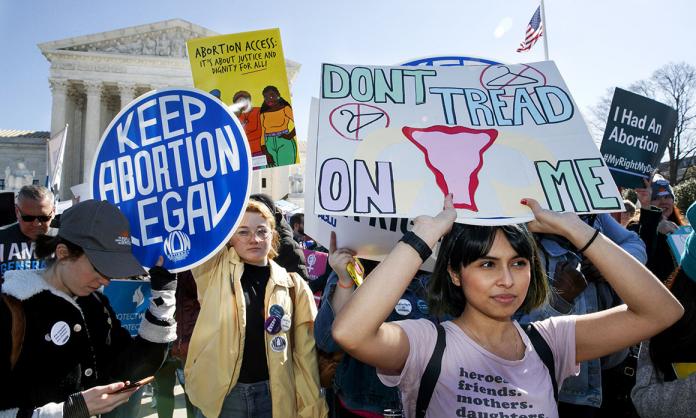In Guanajuato, Mexico, activists are breaking laws to help women terminate unwanted pregnancies. The women are not from Mexico, which last year decriminalised abortion. They’re from Texas, where abortion was effectively banned last September. And they’re preparing to help many more US women over the course of 2022 in anticipation of the possibility that the 1973 Roe v Wade Supreme Court ruling will be overturned, jeopardising the reproductive freedom of tens of millions of US women.
Roe v Wade was a landmark victory for women’s rights, establishing abortion as a constitutional right. There were limits to this victory: it did not establish abortion as an unqualified right and nor did it mean access to abortion services would be available to women to exercise the right. But it represented a major gain nevertheless.
The Supreme Court has been prompted to revisit Roe by a Mississippi law banning abortions from 15 weeks. Prior to anti-abortion conservatives constituting a majority of the bench, such challenges to Roe tended not to get a hearing, in effect protecting the ruling and abortion rights. With a conservative majority, this has changed.
There are two likely outcomes of the decision on the Mississippi law, due in mid-2022. Either a precedent is set that restricts abortion access to 15 weeks and undermines but does not entirely overturn the gains of Roe, essentially by fudging the point at which foetal viability is considered to apply. Or, Roe is entirely repealed, opening the way for states to impose any restrictions they choose on abortion rights. Given the composition of the Supreme Court, the latter is the more likely scenario.
Republicans have long been preparing for this, drawing up bills state by state which can be rushed through in the event Roe is overturned. As many as 26 states are expected to enact such laws. The Guttmacher Institute estimated in 2020 that the majority of American women of reproductive age live in states hostile to abortion rights. Without Roe, almost 40 million women will likely lose the right to access abortion in their state.
This is a serious escalation in a country which, because of its political landscape and history, is a conservative outlier on abortion. Reproductive freedom is not seriously contested in most liberal democracies today, as evidenced by the recent legalisation of abortion in some of the world’s traditionally most Catholic countries, like Ireland, Mexico and Argentina. It has mainly been in countries with repressive, hard-right governments, like that in Hungary, that have been going the other way. Why is the US such an anomaly on this question?
The US is a more Christian country, by almost every metric, than the rest of the wealthy Western world. In 2020, the Pew Research Centre found that nearly two thirds of people in the US were Christian, compared to 44 percent in Australia.
But it is not just individual religiosity that has shaped American politics. The country has an organised, right-wing Christian political movement that is a serious force in its own right. It influences the wider Christian population, including less political Christians for whom religious identification trumps class or other loyalties.
Texas shows how the Christian right has used its apparatus to change the reality of abortion access on the ground and dominate political debate. The Texan population is, like the wider American population, almost evenly divided on abortion. In fact, a poll from February 2021 found that 37 percent of Texans wanted abortion laws liberalised, while 32 percent favoured more restrictions. But in September, Texas passed a “heartbeat” law, effectively banning abortion after six weeks.
Before the law was passed, there were already ten times as many anti-abortion “pregnancy centres” funded by Christian organisations than there were abortion clinics in the state: about 200 and 24 respectively. Christian organisations have for years ensured full-time activists are stationed outside clinics, harassing women and coercing them into one of the anti-abortion centres often strategically located next door. The centres are sufficiently well-funded to offer essential services—like ultrasounds—free of charge.
The provision of free medical services gives a sense of the Christian right’s capacity to throw financial and other resources at the anti-abortion movement, but it only reflects a small part of the effort. The Christian right also uses the legal system to its advantage, building its own Christian law schools to train armies of lawyers ready to argue its case around the country, chipping away at abortion access with the explicit goal of one day overturning Roe. One of these law schools produced Amy Coney Barrett, Trump’s final appointee to the Supreme Court who is now considering the Mississippi case.
Importantly, the Christian right also has immense political influence. The entwinement of the Christian right and the Republican Party from the 1970s onwards was the result of a symbiotic process. Firstly, conservative Christian leaders looked to gain greater political influence in reaction to the gains of social movements. Party lines, on the other hand, had been realigning as the Democratic voting base shifted north and Republicans found a conservative audience in the traditionally Democratic south. The partnership was cemented when Evangelical leader Jerry Falwell’s “Moral Majority” movement helped elect Ronald Reagan in 1980. A born-again identity became a pre-condition for Republican presidential candidates and in the decade following, the Christian right gained a grip on the party in many parts of the country. By 1994, it essentially controlled the party in 18 states and held major influence in another 14—through filling caucuses and conventions with religious activists, lobbying and becoming a major source of funding. That year, the Republican Party won control of both houses of Congress for the first time in 40 years, a victory in no small part due to the Christian (especially evangelical) vote.
Plenty of non-religious right-wingers were also hostile to abortion rights. Their political perspective tended to made them natural allies of the religious anti-abortionists. They resent progressive social movements and women playing too much of a role in public life at the expense of their families and by association the social fabric. Sexual expression on the part of women, in their eyes, should be sanctioned unless it pertains to procreation or pleasing their husbands. And they see discipline, responsibility and punishment as central to maintaining societal order, and are happy to use the state to intimately control people’s lives when it suits their conservative agenda.
Although male-dominated, such conservatism is not the exclusive preserve of men. In 2021, 43 per cent of American women self-identified as pro-life, and research by Ziad Munson in 2008 suggested that women made up the majority of anti-abortion activists.
By backing Trump in 2016 and delivering him 81 percent of the white evangelical vote, the Christian right struck gold. Trump crowned evangelical Mike Pence his Vice President and appointed conservatives to judiciaries across the country. But, more than anything else, he repaid the Christian right with his three appointees to the Supreme Court, giving it the opportunity to realise its dream of overturning Roe.
The Democratic Party is widely seen as the pro-choice party in the US. But the party’s weak support for abortion rights is a big part of the reason reproductive freedom is now under major threat.
The association of pro-choice and pro-life positions with the Democratic and Republican camps respectively is a relatively recent phenomenon. Both parties historically were home to a mix of pro- and anti-abortion candidates until the realignment in the 1960s and 1970s that eventually secured strong Republican support in the South.
Today, being pro-choice in the Republican Party is implausible, but the options for Democrats are more flexible. In the South, especially, they have a chequered record. In 2019, Kentucky Democrat John Sims voted for a “heartbeat” bill similar to the new Texas law. That same year in Louisiana, the pro-life Democratic Governor John Bel Edwards signed a similar law—that was sponsored by another Democrat, John Milkovich—into existence. Joe Manchin of West Virginia has described himself as “pro-life and proud of it”.
In Mississippi, a law passed in 2007 banning abortions in almost all circumstances will be triggered if the state is successful in its campaign to have Roe overturned. Two of the legislators that were instrumental in getting this law passed were Democrats, one of who later became chairman of the state Democratic Party.
Bill Clinton popularised the slogan that abortion should be “safe, legal and rare” in his 1992 presidential campaign. This was an attempt to appease conservative moralisers opposed to reproductive choice without alienating liberals. Obama’s Affordable Care Act—hailed as improving women’s health care—was accompanied by an executive order that restated the 1976 Hyde Amendment’s ban on almost any federal abortion funding for poor women.
Biden has a notably bad history on abortion: in the 1980s he voted to allow states to overturn Roe and against funding abortions as part of a health care plan for federal employees, and wrote his own amendment to ban the use of foreign aid for abortion research. His continued silence on the issue since becoming President has been so worrying to abortion rights supporters that some have created a website—didbidensayabortionyet.org—dedicated to tracking whether he has even said the word since being elected (the answer, after almost 400 days in office, is no).
The administration is, on paper at least, committed to upholding Roe. Its strategy, though, seems to rest not on mounting a campaign to defend abortion that could pressure the Supreme Court and threaten social chaos if abortion rights are scrapped, but on promising access will be safeguarded where electorates remain under Democratic control. It is a strange “defence” of abortion rights that involves conceding defeat in roughly half of the country at the outset, but at least Democrats are fortifying abortion rights where they have the power to do so, right? Not if the example of Virginia is anything to go by.
Virginia is a “battleground” state, one of few in the south that is closely contested. Its Governorship had been held by a Democrat since 2014, but was won by a Republican in early November. During that election, Democrats promised to be a “brick wall” against anti-abortion legislation. But in the more than two months the Democrats had to codify abortion access before the pro-life Republican took over and with the decision on Roe looming they did nothing. Or more accurately, they went on holiday. “We discussed it,” Democrat majority leader Richard Saslaw told the New York Times, “there are too many people out of town”.
Why is the Democratic Party so shy about abortion? Because it doesn’t want to give up on appealing to conservative voters and winning parts of the South on a right-wing basis. The result is that the aggressive Christian right and Republican Party are able to set the terms of the debate and erode reproductive rights.
And because so much of the pro-choice movement is oriented to the Democrats, its approach tends to be disastrously defensive. As Katha Pollitt wrote in her 2014 book Pro: Reclaiming Abortion Rights put it, “For far too long the pro-choice movement was either complacent or defensive. It relied on brilliant lawyers and sympathetic judges, while abortion opponents built a grassroots movement and took over political offices from zoning boards and school boards to the legislature itself. It sold itself too cheaply to the Democratic Party, even when the Democrats were seeking out anti-abortion and anti-feminist candidates to run in conservative districts. It let its mostly white leadership age in place, pursuing their tired Beltway-focused strategies, and then wondered why young women and working-class women of color didn’t connect with its organizations.”
The US is in desperate need of an unapologetic defence of abortion rights oriented to activism to match the determination and organisation of the right. Anti-abortionists have built an aggressive grassroots movement while much of the pro-choice camp has placed its hope in Democrats. Even in places like Texas, statistics show that there is sizeable—in fact, sometimes majority—public opinion waiting to be mobilised by abortion rights activists. But without a movement that can galvanise its supporters and give them confidence to fight, sentiment counts for very little. The majority of US women are at imminent threat of their reproductive freedom being taken away. The stakes have never been higher.










